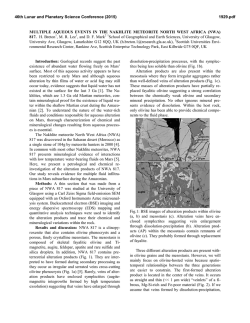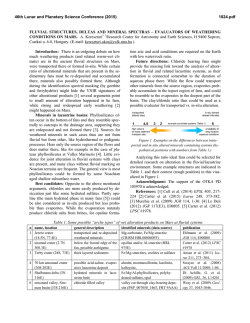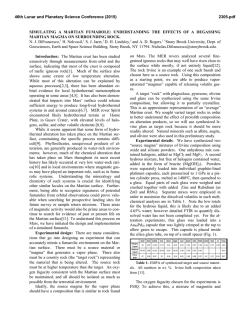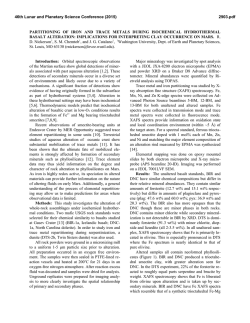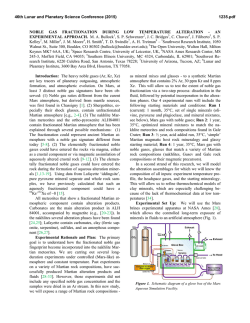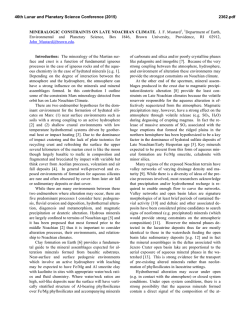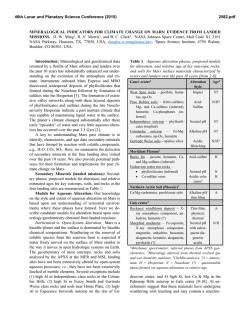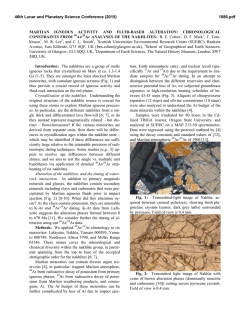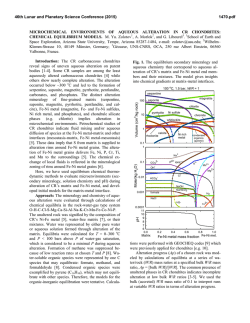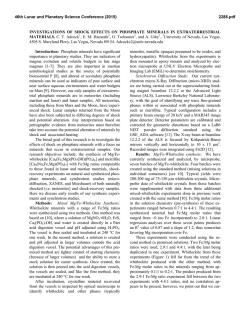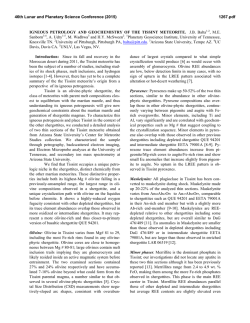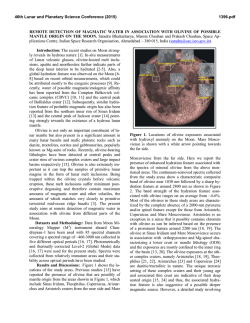
Secondary Minerals in the Nakhlite Meteorite Yamato 000593
46th Lunar and Planetary Science Conference (2015) 2010.pdf SECONDARY MINERALS IN THE NAKHLITE METEORITE YAMATO 000593: DISTINGUISHING MARTIAN FROM TERRESTRIAL ALTERATION PRODUCTS. H. Breton1, M. R. Lee1, and D. F. Mark2 1 School of Geographical and Earth Sciences, University of Glasgow, University Ave, Glasgow, Lanarkshire G12 8QQ, UK ([email protected]), 2Scottish Universities Environmental Research Center, Rankine Ave, Scottish Enterprise Technology Park, East Kilbride G75 0QF, UK Introduction: The nakhlites are olivine-bearing clinopyroxenites that formed in a Martian lava flow or shallow intrusion 1.3 Ga ago [1, 2]. They are scientifically extremely valuable because they interacted with water-bearing fluids on Mars [3]. Fluid-rock interactions led to the precipitation of secondary minerals, many of which are hydrous. The secondary minerals consist in a mixture of poorly crystalline smectitic material and Fe-oxide, collectively called “iddingsite”, but also carbonate and sulphate [4]. The proportion, chemistry and habit of the secondary minerals vary between members of the Nakhlite group, which is thought to reflect compositional variation of the fluid within the Martian crust [5]. However, some secondary minerals are quite similar to terrestrial alteration products and thus the chemical and textural variations could also reflect terrestrial contamination (deposition or exchange). Identifying the origin of the secondary minerals is not straightforward but essential to unravel the Martian fluid chemistry and conditions. Yamato 000593 (Y-000593) is a nakhlite meteorite that was discovered in Antarctica near the Yamato Mountains by the Japanesse Antarctic Research Expedition in 2000-2001 [6]. Most of the meteorite is covered by a black shiny fusion crust but it also has deep erosion features in its underside that probably formed by freeze- thaw cycles. As in most other Nakhlites, Y 000593 contains iddingsite-like alteration products believed to have been formed on Mars because they have devolatilization features at the vicinity of the fusion crust [7]. Additional evidence of Martian aqueous alteration is the presence of laihunite, a high temperature oxidative alteration product of fayalitic olivine [8]. The secondary minerals in Y-000593 can provide a powerful insight into the Martian hydrosphere from high to low temperature environments with implications for the origin, cycling, and availability of water on Mars. However, it is highly likely that some secondary minerals have formed on Earth which can biased our understanding of the Martian groundwater chemistry. With this in mind, we are trying to identify all the different secondary minerals and document their spatial and textural relations, their mineralogy and chemistry to better constrain their possible origin and the impact that terrestrial fluids may have had on the Martian alteration products. Methods: A thin section of Y-000593 was studied using a Carl Zeiss Sigma field-emission SEM equipped with an Oxford Instruments Aztec microanalysis system at the University of Glasgow. Chemical and mineralogical identification within the secondary minerals were obtained through backscattered electron (BSE) imaging and energy dispersive spectroscopy (EDS) mapping and quantitative microanalysis. Results and discussions: Y-000593 is an unbrecciated cumulate rock whose mineralogy is similar to other nakhlites: a predominance of augite and minor olivine phenocrysts surrounded by a microcrystalline mesostasis [9]. Although augite is the most abundant mineral, it contains only rare traces of secondary minerals which include Ca-sulphate filling fractures and phyllosilicate replacement (recognized by their habit and crystallinity). Unlike augite, olivine phenocrysts have a variety of alteration textures and products (Fig. 1). Alteration products commonly enclose symplectites suggesting that they formed after the augite-magnetite intergrowths and by selective replacement of olivine. Most of the alteration products are confined within veins few µm-thick cross-cutting olivine. Outside of these veins, olivine is discontinuously replaced by an alteration product, already identified as laihunite [8], which has a characteristic fine-scale channel-like micro-texture (Fig. 1). The distribution of the laihunite is strongly controlled by grain boundaries, lamellae symplectites and veins from which it seems to have developed. X-ray elemental imaging of the laihunite reveals no major compositional difference relative to unaltered olivine. It shows only a slight depletion in Fe and enrichment in O suggesting partial dissolution of olivine by water-bearing fluids. No changes in Mg content have been detected; however laihunite shows traces of S most probably present as adsorbed ions within the channels. Olivine-hosted iddingsite veins are zoned with a complex secondary mineral assemblage. Alteration products present along vein axes do not show evident crystals or grains at the SEM scale. They are enriched in Si, Mg, and O with lower concentration in Fe and rare Al. This material is commonly surrounded by a discontinuous, fine layer of Fe-Mn-oxide. Both mineral phases represent the Martian “iddingsite” common to 46th Lunar and Planetary Science Conference (2015) most nakhlites. The “iddingsite” has largely been replaced coarser minerals enriched in Fe, Mn, Al, S, P, and Cl but poorer in Si and Mg. The proportions of these components varies at the (sub)µm-scale. Finally, the different materials are cross-cut by a K-Fe-Sbearing mineral phase (jarosite?). The presence of different mineral phases in cross-cutting and overgrowing relationships points toward multiple episodes of secondary mineral deposition. 2010.pdf The other mesostasis alteration product occurs mostly within the phyllosilicates. It is highly porous, fibrous and composed mostly of Fe and Mn, with low concentration of Si and variable P, S, and Cl. The occurrence of Si and the fibrous texture suggest the presence of a phyllosilicate mineral. The ionic components may represent either a co-precipitation of salts with the phyllosilicate mineral or a substitution of OH molecules by anions. This alteration product is similar in composition (albeit poorer in Si) and texture to that overgrowing the olivine-hosted “iddingsite”, suggesting that they may have precipitated from a same fluid but with a micro-environmental control on the fluid chemistry. It was most probably the last to crystallize and may be of terrestrial origin. The occurrence of anions may be the result of dissolution of primary minerals such as pyrrhotite and apatite. Fig. 1: BSE image of olivine-hosted laihunite and alteration veins with iddingsite and S-P-Cl-bearing mineral. Laihunite develops along narrow fractures from which it replaces olivine. The mesostasis also contains significant amounts of alteration products. They are not restricted to veins but rather form concentrated masses replacing different igneous phases especially pyrrhotite, Ti-magnetite, augite, and plagioclase feldspar (Fig. 2, 3). The alteration products are composed of a fine mixture of two different types of secondary mineral. One forms layers surrounding and replacing primary minerals although it has never been found associated with altered olivine. This alteration product is fibrous and composed of Si, Fe, Mn, Mg, and Al. Traces of P, Cl and S have been detected although it may reflect mixed analysis with the other alteration product. Both its microstructure and chemical composition suggest that it is a phyllosilicate. Fig. 2: Two different alteration products (1 and 2) replacing an unusually large grain of pyrrhotite Fig. 3: Zoned phyllosilicates replacing mesostasis and broken augite phenocrysts. Conclusions: Martian alteration products in Y000593 include laihunite and iddingsite, both strongly associated with olivine phenocrysts. Terrestrial alteration products possibly include the phyllosilicates together with an anion-bearing mineral (S, P, and Cl). These latter components do not form well-defined veins but commonly replace primary material and occur in shocked areas. The relative timing of the alteration material containing the anionic constituents S, P, and Cl is difficult to constrain, but may represent the latest alteration products that formed by terrestrial processes. References: [1] Lentz F. R. C. Et al. (1999) Meteoritics & Planet. Sci., 34, 919-932. [2] Nakamura N. Et al. (1982) Geochim. Cosmochim. Acta, 46, 1555-1573. [3] Gooding J.L. (1997) Icarus, 99, 28-41. [4] Bridges J.C. et al. (2001) Space Sci. Rev., 96, 365-392. [5] Tosca N. J. and McLennan S. M. (2006) EPSL, 241, 21-31. [6] Misawa et al. (2003) Antarct. Meteorite Res., 16, 1-12. [7] Imae et al. (2003) Antarct. Meteorite Res., 16, 13-33. [8] Noguchi et al (2009) J. of Geophys. Res., 114, 1-13. [9] Imae et al. (2005) Meteoritics & Planet. Sci., 40, 1581-1598.
© Copyright 2026
